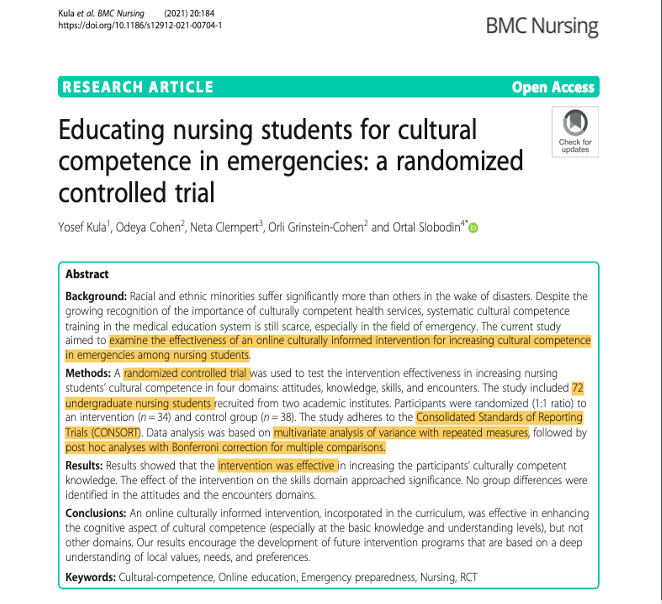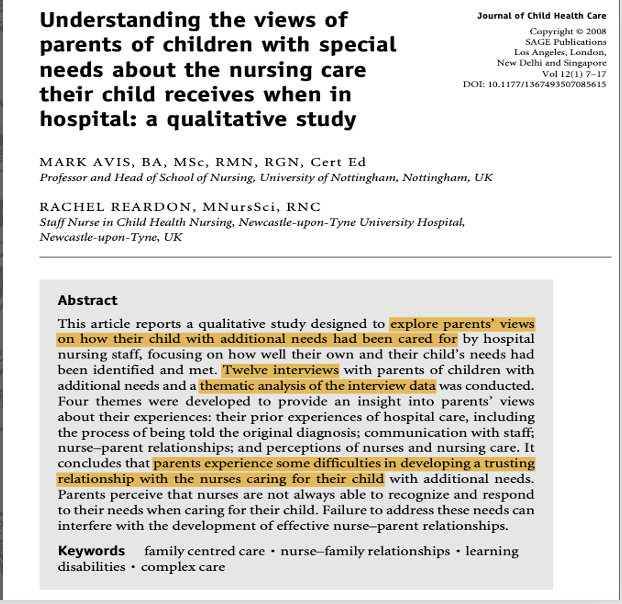NURS-1001: Week 7: Ways of knowing and being as a nurse
NURS-1001: Week 7: Ways of knowing and being as a nurse
- Nursing research:
- “The primary means by which new knowledge is discovered and brought into practice to improve the care that nurses provide to their patients.” (Potter & Perry, 2022)
- Evidence-informed decision-making:
- “an ongoing process that incorporates evidence from research findings, clinical expertise, client preferences, and other available resources to inform decisions that nurses make about clients” (Canadian Nurses Association, 2018).
- Evidence Appraisal
- Clinical expertise
- Ongoing learning
- Application of the evidence
- Difference between research and evidence-based practice:
- Research:
- Generate new knowledge or validate existing knowledge based on theory
- Evidence-based practice:
- To use the best available evidence to make informed patient care decisions
- Research:
- Quality improvement:
- Systemic approach:
- Enhance quality of patient care and healthcare system by improving local work processes
- Data collection:
- Asses clinical processes, patient outcomes, and other relevant metrics
- Specific population:
- Measures a specific population to identify areas for improvement, implementing changes, and evaluating outcomes
- Analyze data:
- Identify trends, areas of concern, and opportunities for improvement Can involve statistical analysis to pinpoint areas with the greatest need for enhancement
- Systemic approach:
- Nursing knowledge:
- Continuously evolving
- Life long learning
- Different areas of knowledge
- Knowledge from research and evidence
- Must know how to find the evidence
- Research the evidence:
- Ask a question presenting the clinical problem
- Search for and collect the evidence
- Critically appraise the evidence
- Integrate all evidence with clinical expertise, patient’s preferences and values to make a practice decision or change
- Evaluate the outcome of the practice decision or change
- Disseminate the outcomes
- Ask a question:
- P:
- Patient population
- I:
- Intervention of interest
- C:
- Comparison of interest
- O:
- Outcome
- P:
- Question:
- Does single component DBT reduce the rates of suicidality and self-harm in females aged > 18 years old and diagnosed with borderline personality disorder?
- P
- Females >18 yo with BPD
- I
- Single component DBT
- C
- Usual care – multicomponent DBT
- O
- Decrease in suicidality and self-harm
- P
- Finding the evidence:
- Best practice guidelines
- RNAO, CNO
- Reputable sources
- OMNI, PubMed, Cochrane
- Key words
- Operator words
- AND, OR, NOT
- Best practice guidelines
- Evaluating the evidence:
- Source
- Authors credentials
- Research design
- Sample size and selection
- Data analysis
- Peer reviewed
- Funding source
- References
- Replication
- Informed vs misinformed evidence:
- Informed:
- studies and investigations conducted with a high degree of knowledge, accuracy, and adherent to scientific principles
- Misinformed:
- studied conducted with errors, biases, or inaccuracies leading to flawed or unreliable results
- Informed:
- Integrate the evidence & evaluate outcome:
- Incorporate into clinical practice
- Evidence as rationale for interventions
- Collaborate to initiate change
- Evaluate efficiency of change
- Disseminate the outcomes:
- Stakeholders
- APA 7th
- Initiate change across healthcare system
- Quantitative vs qualitative:
- Quantitative:
- Research that can be precicely measured and quantified
- Statistical analysis
- Ex. Randomized controlled trials, surveys, questionnaires
- Qualitative:
- Research that seeks to undersdtand the prespective of the person related to a specific issue
- Thematic, content, or narrative analysis
- Ex. Ethnographty, narrative inquiry, descriptive research
- Quantitative:


MEOW MEOW MEOWMOTHER FUUUUUUCCCCKKKKEEEEERRRR 🐈
- Ethics in research:
- Ethical review boards:
- Institutional Review Board
- Ethics Committees
- Ethical principles:
- Respect for persons
- Concern for welfare
- Justice
- Participant consent:
- Informed
- Voluntary
- Ethical review boards:
- Carper’s ways of knowing:
- Barbra Carper in 1978
- Patters of knowledge and ways of understanding nursing and healthcare
- 4 patterns:
- Empirical
- Aesthetic
- Ethical
- Personal
- Empirical knowing:
- Science of nursing
- Informs clinical decision making
- Empirical data
- Research findings
- Scientific method
- Aesthetic knowing:
- The art of nursing
- Develop a deeper understanding of the patients experience
- Intuition
- Personal perception
- Creativity
- Ethical knowing:
- The moral and ethical dimensions
- Respects the dignity and rights of patients
- Values
- Ethics
- Principles
- Personal knowing:
- The personal component
- Focus on self-awareness and self-understanding of the nurse
- Biases
- Values
- Beliefs
- Personal experiences
- Challenges and critiques:
- Overlapping categories:
- Challenging to categorize knowledge neatly into one specific pattern
- Cultural sensitivity:
- Does not address cultural variations
- Reduction:
- Potentially over simplifying nursing
- Evolution in practice:
- Healthcare has evolved since theory was founded.
- Overlapping categories:
- Future direction:
- 5th pattern of knowing
- Increase critical reflection
- Healthcare technology
- Synthesizing the ways of knowing:
- Ethical
- Empirical
- Aesthetic
- Personal
- Case study example- terminally ill patient:
- 65 year old patient with advanced metastatic cancer is admitted to hospice care.
- Empirical Knowing
- evidence-based guidelines for pain management and symptom control
- Administer prescribed medication and conduct assessments
- Aesthetic Knowing
- Understanding patients unique experience – listening to patient fears and concerns
- Calming environment with music and soft light
- Ethical Knowing
- Supporting patients end of life decisions
- Balancing patients autonomy, beneficence, and nonmaleificence
- Personal Knowing
- Nurse reflect on emotional reactions to patient’s terminal diagnosis and end of life decisions
- Provide care without projecting feelings onto patient/family
- Health & wellness:
- Health:
- Person’s overall physical, mental, and social wellbeing
- Free from illness, injury, or disease
- Continuum
- Wellness:
- Holistic approach to achieveing and maintaining state of wellbeing
- Actively promoting a healthy lifestyle
- Various dimenstions; physical, emotional, mental, social, spiritual
- Health:
- Biomedical model of health:
- Health is the absence of absence of disease - goal to treat existing health conditions
- Characteristics:
- Disease centred
- Simplicitic
- Medication intenventions
- Objectivity
- Individual focused
- Acute care applications
- Biopsychosocial model of health:
- Health is influenced by interplay of biological, psychological, and social factors – acknowledges health prevention
- Three domains:
- Biological factors
- Psychological factors
- Social factors
- Mind-body connection:
- Relationship between psychological wellbeing and physical health
- Considerations:
- Psychosomatic effects
- Immune system
- Pain perception
- Interventions
- Emotions
- Placebo effect
- Cultural views of health:
- Health models
- Beliefs and values
- Spirituality
- Traditional healing practices
- Cultural norms
- Gender roles
- Stigma and mental health
- Summary:
- Nurses use knowledge from different sources to inform nursing practice to improve patient outcomes. Nurses must be aware of the research process to be able to collect evidence to inform practice. The ways of knowing as a nurse defines patterns of knowing, that is applied to care. There are different models of health that can be influenced by culture.
- Next week:
- Discussing nurses role in safety (patient, nurse, and organizational safety)
- Racism and discrimination in healthcare and the nurses role
- CASE STUDY:
- Empirical knowing:
- Medication
- Addressing the wounds and perfoming pain management beforehand
- Aesthetic knowing:
- Stay calm and talk to the grandmother in a nice way
- Guiding the art and the patient
- Used inutition and instinct to recognize the tense situation
- Ethical knowing:
- Doing whats write for the boy and his grandmother
- Reflecting on her own feelings
- Obligation to report child abuse
- Personal knowing:
- Grandmother feeling uncomfortable